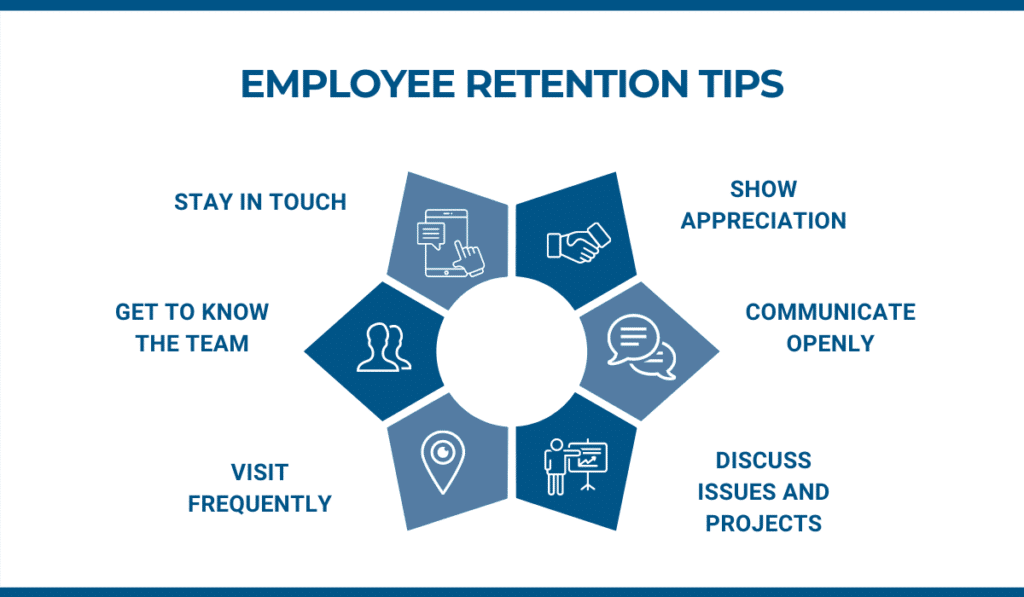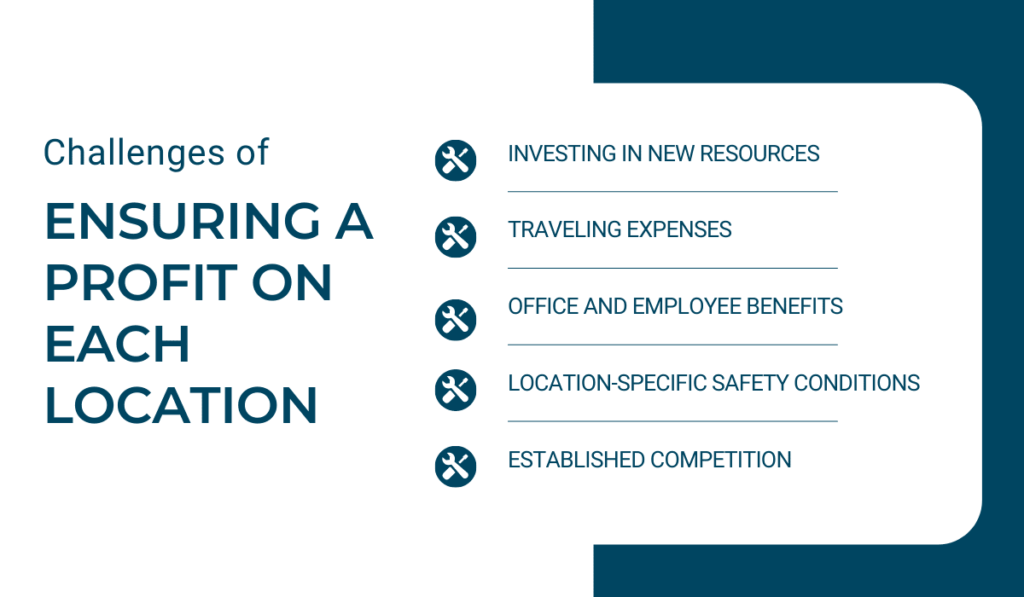If you’re trying to manage multiple office locations at once, you know it’s not easy at all.
On top of pushing for the office to reach company goals, you have to take care of the employees, communication, and team spirit, among other things.
This article will explain the eight main challenges you will face and how you can overcome them. Each one of the challenges can prove fatal to the office as they can all negatively affect productivity.
If you’re interested in solving the eight possible issues, keep reading!
In this article...
Cross-Company Communication
One of the biggest challenges of having multiple locations is cross-company communication.
There are many reasons why communication is lacking between your offices, but it’s often because they’re physically distant from your headquarters and all the other locations.
The real issues begin when that communication peters out to an unsustainable degree.
You should know what is going on in each location and understand the specific problems the employees there face. Otherwise, they will feel distant from you, and there won’t be any connection.
To ensure that you have a line of communication with each office, set up weekly calls and try to include more than just the managers—you should hear how the employees feel working for you.

Understand the struggles of each office and create a plan to help them.
Communicate changes on a company level and ensure that everyone gets important emails and attends crucial meetings.
On top of that, you can use Microsoft Teams or Slack to promote cross-company communication between yourself and the employees who work in more remote locations.
Show them you’re always willing to listen and respond to their queries to encourage them to contact you more often.
Promote cross-company communication to overcome the challenge of a multi-office company.
Location Management
The successful management of each location is also a challenge.
Since you can’t be at each office every day, it’s impossible for you to personally manage the locations. If you did that, you’d have no time left for doing your job.
Instead of visiting daily, you should hand the task over to reliable employees and make them office managers.
That way, you’ll have someone in charge of each of your offices, and the person can report directly to you daily to ensure that you’re in on the inner workings of the location.
You’ll get to hear how the office is progressing and what their main issues are.
Moreover, you will be able to help more than if you only visited the office from time to time.
Having reliable people on the spot lets you gather more information and assist the team better.
Of course, having a manager doesn’t mean that you shouldn’t be directly involved with the functioning of the offices.
You should still visit them, talk to the employees, and promote unity across the locations. If you don’t take the time to check in on the employees and see how things are progressing, you’ll alienate them.
Managing each office location is a challenge you must overcome for better office management.
Logistics
Logistics can pose a problem to the successful management of multiple offices.
When opening a new office, you have to take that factor into account. The initial cost might just be a fraction of the total amount you’ll end up with when you add all the logistical expenses.
For example, when moving your inventory to a new location, you need to understand how far away from the main office the new site is to figure out how much the move will cost.
Then, you have to determine how often the employees will have to visit the main office, if at all.
You can send some data over email, but this is not the case for sensitive information or documentation that needs to be saved on paper.
Besides, tracking your assets across multiple locations can be almost impossible if you don’t use software that helps you create an inventory.
Since you’re not on the site, you don’t have an overview of the assets there, and you don’t hear about damage or malfunctions right away.
You need to use asset tracking software to give your team the option to inform you or the maintenance team of inventory damage or malfunctions right away so you can eliminate unnecessary downtime and fix the problem ASAP.
Having multiple offices means that you have to find an effective way to deal with logistics.
Employee Retention
One of the most vital yet demanding elements of managing multiple offices is employee retention.
Of course, as a company, your goal is to have highly skilled and trained professionals working for you.
This goal becomes difficult to achieve if your professionals leave, making you invest resources into hiring and training new employees.
So, instead of wasting time and energy on the hiring process, invest them in your existing employees.
The first challenge is staying in touch with your employees across locations.
Solve it by taking the time to get to know the team in the office, visiting them frequently, and discussing issues and projects with them in person.
Frequent conversations will make them feel comfortable communicating with you.

You also need to encourage your team to get in touch with you. If you leave the line of communication open, the employees will be more likely to contact you when you’re in the main office, and an issue arises.
On top of that, employees who feel appreciated are more likely to stay with the company.
That’s why it’s crucial for you to personally compliment and congratulate team members on their effort and achievements.
Even if you don’t feel like that’s a lot, being recognized by the manager is a huge motivator for employees.
Improve employee retention by investing time in your employees.
Training Opportunities
If you have multiple offices, training opportunities can be difficult to manage.
First, you have to ensure that each location receives the same training.
If you give completely different instructions to one office or skip a thing or two in your training of another, they will not achieve the same results and will not be on the same page.
Write down all the main points and ensure that you go through each of them with each of your offices to ensure standardization.
You also have to consider their differences—not every office has the same needs.
Of course, the initial training has to be the same across all locations to guarantee that everyone has received all the necessary data.
However, you will notice the differences between office needs in time. One office will be behind on sales, another on customer satisfaction, and the third on something completely different.
You will have to monitor each office and understand what their weak points are to organize training for them.
For example, there’s no use in deciding everyone needs refreshment training on customer communication if only one office isn’t good at it—it would be a waste of resources.
Training multiple offices can be demanding because of different locations and needs.
Location-Specific Goals
Another obstacle to effective management of multiple locations is creating goals for each one.
Your employees should know what your company goals are and the role they play in achieving them.
However, while the overall company goals will stay the same, you have to change the way each office gets there.
Basically, create location-specific objectives directly relating to an overarching company goal.
While all offices must follow the standardized rules and strive to achieve the same goals, they might never be on the same level.
For example, one of your offices can be great at communication but bad at reporting.
Their office-specific goal could be to create more reports to get more practice, which employees can do by dedicating half an hour a day to the weekly report.
Another office can be in a location where your products or services are considered a luxury, so it won’t generate as many sales as a city office.
The sales goal for such sites needs to be adjusted accordingly.
You will get valuable intel from the employees and the managers. Work with them to understand what their location is struggling with and create a plan to improve and reach the office-specific goals, which should always relate to the overall company objectives.
Work with the office team to create location-specific goals that relate to the overall objectives.
Making a Profit on Each Location
Making a profit on each of your office locations is more challenging than it seems.
Firstly, each new location will cost you.
You have to invest resources in the office itself, its employees, and the inventory.
Then, there are the many expenses related to traveling to the office for meetings, and all the different benefits you offer to employees in the office.
On top of that, it will take a while before the office runs independently and makes a profit. Take that into consideration when calculating overall expenses.

You should also consider location-specific goals.
However strange it may sound, the geographical position affects the efficiency of your office.
Specific neighborhoods are safer than others, which can affect the profile of customers who come to your office.
Then, the location also shapes the competition.
If you open an office in a part of town where there’s already a lot of similar businesses, that office is more likely to fail than those located in parts of town with fewer competitor firms around.
Consider these aspects before opening an office, but keep an eye on them throughout.
If you notice that a location simply isn’t improving and constantly fails to meet standards, maybe it’s time to move the office to a different site that suits your company’s needs better.
Think of all the location-related expenses and disadvantages to ensure profit.
Team Spirit
Promoting team spirit across multiple locations is another aspect of managing many offices you’ll have to face.
Team spirit affects the employee’s well-being and makes the team collaborate more, making them more productive.
Without communication, they can’t help one another out with similar tasks, which is wasted potential.
Often, your employees don’t even know each other, let alone think to contact the other offices to get updates from them.
It’s time for you to change that, especially if you consider that collaboration in the workplace boosts productivity from 20 to 30 percent—you must get the teams to work together and help each other grow and learn.
There is another exciting benefit of team spirit.
Research shows that a sense of community in the workplace is why 54% of employees are more likely to stay at a company—even if it’s against their better interest.
Employees value a company that fosters a culture of community and team spirit.
Improve team spirit by organizing cross-company meetings where employees have the chance to meet each other in person.
If there are similar or even the same work positions in multiple offices, you can introduce people who perform the same roles across these locations and encourage them to stay in touch for work advice.
You should also invest in fun team-building activities to promote team spirit and bring your team closer together.
Encourage and promote cross-office communication to nurture team spirit.
Conclusion
If you want to manage each office location successfully, communicate.
Offer ways for your employees to contact you and each other to promote team spirit and bring everyone closer together.
Since you won’t be able to be at all locations daily, appoint managers who will oversee offices and report their progress.
Before opening the offices, think about the costs and logistics. Also, invest in software that lets you track your assets and update data in real-time for easier communication.
You also need to create location-specific goals and provide your teams with sufficient training and information to reach them. Good luck!









